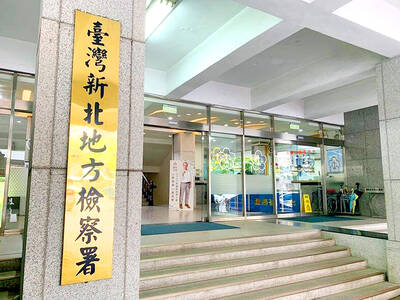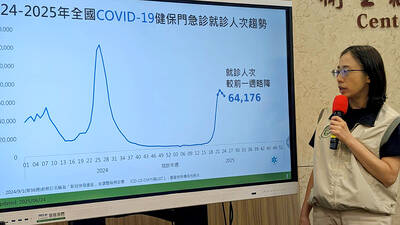Surprised scientists say that typhoons that hit Taiwan unleash long, slow earthquakes, a phenomenon that may save it from more devastating temblors.
Seismologists installed movement sensors in boreholes at depths of 200m to 270m in eastern Taiwan, monitoring a spot where two plates, the Philippine Sea Plate and the Eurasian plate, bump and jostle in an oblique, dipping fault.
Over five years, researchers saw a remarkable correlation between tropical storms and “slow” earthquakes, a seismic beast first identified three decades ago.
Slow quakes entail a slippage in the fault that unfolds progressively over hours or days, rather than a sudden, violent release of the kind that destroys buildings and lives.
The sensors noted 20 such slow earthquakes, 11 of which coincided with typhoons, during the study period.
The 11 quakes were all stronger and characterized by more complex seismic waveforms than other “slow” events.
“These data are unequivocal in identifying typhoons as triggers of these slow quakes. The probability that they coincide by chance is small,” said coauthor Alan Linde of the Carnegie Institution for Science in Washington.
A typhoon causes a fall in atmospheric pressure — and the researchers suggest that this in turn reduces pressure on the land over the fault.
As a result, one side of the fault lifts slightly, causing the pressure that has been building up inside to be released.
“This fault [in Taiwan] experiences more or less constant strain and stress buildup,” Linde said in a press release.
“If it's close to failure, the small perturbation due to the low pressure of the typhoon can push it over the failure limit. If there is no typhoon, stress will continue to accumulate until it fails without the need for a trigger,” he said.
The typhoon does not work as a seismic trigger on faults that lie on the seabed because water moves into the area, dampening out any difference in pressure, the authors theorize.
Often considered a curse, typhoons — for Taiwan — could in fact could be a blessing.
A storm could act as a pressure valve, preventing strain from building up to the point where the fault ruptures devastatingly.
The Nankai Trough in southwestern Japan also lies on the convergence of the Philippine Sea and Eurasian plates.
The plates are converging at a rate of about 4cm per year, which is about half that of the activity in Taiwan.
In theory, Taiwan should be more vulnerable than the Nankai Trough because of the greater slippage, but the record shows that it has had no great earthquakes and relatively few large quakes, Linde said.
By comparision, the Nankai Trough is capable of unleashing a true monster, a magnitude-8 earthquake, every 100 to 150 years.
The paper, published in the British journal Nature, was written by a team led by Liu Chi-ching (劉啟清) of the Institute for Earth Sciences at Academic Sinica.

Prosecutors in New Taipei City yesterday indicted 31 individuals affiliated with the Chinese Nationalist Party (KMT) for allegedly forging thousands of signatures in recall campaigns targeting three Democratic Progressive Party (DPP) lawmakers. The indictments stem from investigations launched earlier this year after DPP lawmakers Su Chiao-hui (蘇巧慧) and Lee Kuen-cheng (李坤城) filed criminal complaints accusing campaign organizers of submitting false signatures in recall petitions against them. According to the New Taipei District Prosecutors Office, a total of 2,566 forged recall proposal forms in the initial proposer petition were found during the probe. Among those

ECHOVIRUS 11: The rate of enterovirus infections in northern Taiwan increased last week, with a four-year-old girl developing acute flaccid paralysis, the CDC said Two imported cases of chikungunya fever were reported last week, raising the total this year to 13 cases — the most for the same period in 18 years, the Centers for Disease Control (CDC) said yesterday. The two cases were a Taiwanese and a foreign national who both arrived from Indonesia, CDC Epidemic Intelligence Center Deputy Director Lee Chia-lin (李佳琳) said. The 13 cases reported this year are the most for the same period since chikungunya was added to the list of notifiable communicable diseases in October 2007, she said, adding that all the cases this year were imported, including 11 from

China might accelerate its strategic actions toward Taiwan, the South China Sea and across the first island chain, after the US officially entered a military conflict with Iran, as Beijing would perceive Washington as incapable of fighting a two-front war, a military expert said yesterday. The US’ ongoing conflict with Iran is not merely an act of retaliation or a “delaying tactic,” but a strategic military campaign aimed at dismantling Tehran’s nuclear capabilities and reshaping the regional order in the Middle East, said National Defense University distinguished adjunct lecturer Holmes Liao (廖宏祥), former McDonnell Douglas Aerospace representative in Taiwan. If

The Mainland Affairs Council (MAC) today condemned the Chinese Communist Party (CCP) after the Czech officials confirmed that Chinese agents had surveilled Vice President Hsiao Bi-khim (蕭美琴) during her visit to Prague in March last year. Czech Military Intelligence director Petr Bartovsky yesterday said that Chinese operatives had attempted to create the conditions to carry out a demonstrative incident involving Hsiao, going as far as to plan a collision with her car. Hsiao was vice president-elect at the time. The MAC said that it has requested an explanation and demanded a public apology from Beijing. The CCP has repeatedly ignored the desires